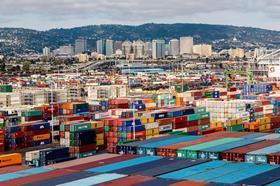
Port of Oakland officials have said that they expect to take on upcoming changes to container shipping alliances with little disruption, news that should be welcomed by importers and exporters fearful of fallout as ocean carriers switch partners in April.
“We’ve spoken to the shipping lines, we’ve spoken to our marine terminal operators and we understand their schedules,” said Port of Oakland maritime director John Driscoll. “We’re confident that Oakland will be able to accommodate the newly formed alliances efficiently.”
The Port said it expects cargo volume to hold steady once new alliances begin operation 1 April. It said fewer but larger ships will visit Oakland weekly, laden with more ocean containers. The change reflects industrywide consolidation as shipping lines cut excess vessel capacity to trim costs.
Eleven of the world’s largest container shipping lines are coming together in three new alliances. The carriers are changing partners after bankruptcy, acquisitions and consolidation roiled container shipping in 2016. Alliances let participating carriers share ships and port calls to reduce expense while expanding service.
The new alliance structure is unnerving some industry experts. They foresee port disruption if arrival schedules change or shipping lines redirect to different marine terminals. The worry is that cargo flow could be inhibited leading to congestion at major ports.
Oakland officials said they don’t foresee difficulties in working with the new alliances. The Port said most of its vessel calls are concentrated in just three marine terminals. That means cargo relocation should be minimal. The Port said it expects to handle 29 weekly and two fortnightly vessel calls in the new alliance structure.
The Port said it could take two-to-three months for all alliance changes to take hold. The process includes slotting vessels into new service rotations. In some cases, older ships will be replaced with newer, larger ones.



